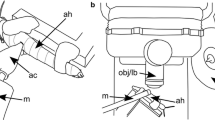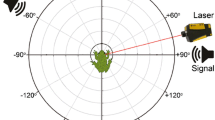Summary
-
1.
The hearing threshold for test sound frequencies above 2 kHz and the directional properties of the intact tettigoniid ear (8 kHz test sound) remain unchanged if sound is prevented from acting on theouter surface of the tympana (Figs. 6, 14). This cannot readily be understood from present theories on tettigoniid hearing.
-
2.
No changes of the hearing threshold above 0.5 kHz or the directionality at 8 kHz can be observed if onlyone tympanum, anterior or posterior, is damped. The hearing threshold shows an increase only afterboth tympana have been damped (Figs. 7, 17).
-
3.
The ear becomes very insensitive to sound and looses the directional properties (8 kHz test sound), characteristic of the intact ear, if the tympanal trachea is blocked at the spiracle on the thorax (Figs. 5, 16). This demonstrates the importance of the sound pathway via the tympanal trachea.
-
4.
The directional sensitivity, i.e. the hearing threshold for a given sound frequency, depends on the relative position between the direction of sound incidence and the tympanal spiracle on the thorax (Figs. 12, 13). The symmetry axis of the directivity pattern (8 kHz test sound) is fixed in relation to the longitudinal axis of the body and does not change if the foreleg is moved into different “walking positions” (Fig. 15).
-
5.
The optimum frequency of hearing of the tettigoniid ear is changed by altering the length of the tympanal trachea (Figs. 9, 19).
-
6.
Two theories, namely the horn and the resonator theory, relating to the acoustical function of the tympanal trachea are discussed.
Similar content being viewed by others
References
Ander, K.: Vergleichend-anatomische und Phylogenetische Studien über die Ensifera (Saltatoria). Opusc. Ent. Lund (1939)
Autrum, H.: Über Lautäußerungen und Schallwahrnehmungen bei Arthropoden II. Z. vergl. Physiol.28, 326–352 (1940)
Autrum, H.: Über Gehör und Erschütterungssinn bei Locustiden. Z. vergl. Physiol.28, 580–637 (1941)
Baier, L. J.: Contribution to the physiology of the stridulation and hearing of insects. Zool. Jb. Physiol.47, 151–248 (1930)
Beranek, L.: Acoustics. New York: McGraw-Hill Book Company 1954
Busnel, M. C.: Contribution à l'étude des émissions acoustiques des Orthoptères. Ann. I.N.R.A.3, 333–421 (1953)
Dumortier, B.: The physical characteristics of sound emissions in Arthropoda. In: Acoustic behaviour of animals (ed. R. G. Busnel). Amsterdam: Elsevier Publ. Co. 1963
Gardner, M. B., Hawley, M. S.: Network representation of the external ear. J. acoust. Soc. Amer.52, 1620–1628 (1972)
Graber, V.: Die tympanalen Sinnesapparate der Orthopteren. Denkschr. kgl. Akad. Wiss. Wien math.-nat.36 (1876)
Katsuki, Y., Suga, N.: Electrophysiological studies on hearing in common insects in Japan. Proc. Jap. Acad.34, 633–638 (1958)
Katsuki, Y., Suga, N.: Neural mechanism of hearing in insects. J. exp. Biol.37, 279–290 (1960)
Lewis, D. B.: The physiology of the tettigoniid ear. I. The implications of the anatomy of the ear to its function in sound reception. II. The response characteristic of the ear to differential inputs: Lesion and blocking experiments. III. The response characteristic of the intact ear and some biophysical considerations. IV. A new hypothesis for acoustic orientation behaviour. J. exp. Biol.60, 821–869 (1974)
Littler, T. S.: The physics of the ear. New York: Pergamon Press 1965
McKay, J. M.: The auditory system ofHomorocoryphus (Tettigonioidea, Orthoptera). J. exp. Biol.51, 787–802 (1969)
Michelsen, A.: Pitch discrimination in the locust ear: observations on single sense cells. J. Insect Physiol.12, 1119–1131 (1966)
Michelsen, A.: The physiology of the locust ear. I. Frequency sensitivity of single cells in the isolated ear. II. Frequency discrimination based upon resonances in the tympanum. III. Acoustical properties of the intact ear. Z. vergl. Physiol.71, 49–128 (1971)
Møller, A. R.: Network model of the middle ear. J. Acoust. Soc. Amer.33, 168–176 (1961)
Morse, P. M.: Vibration and sound. New York: McGraw Hill 1948
Morton, J. Y., Jones, R. A.: The acoustical impedance presented by some human ears to hearing-aid earphones of the insert type. Acustica6, 339–345 (1956)
Murphey, R. K., Zaretsky, M. D.: Orientation to calling song by female crickets,Scapsipedus marginatus (Gryllidae). J. exp. Biol.56, 335–352 (1972)
Nocke, H.: Physiological aspects of sound communication in crickets (Gryllus campestris L.). J. comp. Physiol.80, 141–162 (1972)
Nocke, H.: The tympanal trachea as an integral part of the ear inAcripeza reticulata Guérin (Orthoptera, Tettigonioidea). Z. Naturforsch.29c, 652–654 (1974)
Pumphrey, R. J.: Hearing in insects. Biol. Rev.15, 107–132 (1940)
Quincke, G.: Ann. d. Physik128, 177 (1866)
Regen, J.: Über die Anlockung des Weibchens vonGryllus campestris L. durch telephonisch übertragene Stridulationslaute des Männchens. Pflügers Arch. ges. Physiol.155, 193–200 (1913)
Rheinlaender, J., Kalmring, K.: Die afferente Hörbahn im Bereich des Zentralnervensystems vonDecticus verrucivorus (Tettigoniidae). J. comp. Physiol.85, 361–410 (1973)
Schumacher, R.: Morphologische Untersuchungen der tibialen Tympanalorgane von neun einheimischen Laubheuschrecken-Arten (Orthoptera, Tettigonioidea). Z. Morph. Tiere75, 267–282 (1973)
Schumacher, R.: Beitrag zur Kenntnis des tibialen Tympanalorgans vonTettigonia viridissima L. (Orthoptera: Tettigoniidae). Mikroskopie29, 8–19 (1973)
Siebold, Th.: Über das Stimm- und Gehörorgan der Orthopteren. Wiegmanns Arch. Naturgesch.10, 52–81 (1844)
Stewart, G. W., Lindsay, R. B.: Acoustics. New York: D. van Nostrand Comp. 1930
Suga, N.: Ultrasonic production and its reception in some neotropical Tettigoniidae. J. Insect Physiol.12, 1039–1050 (1966)
Zaretsky, M. D.: Specificity of the calling song and short term changes in the phonotactic response by female cricketsScapsipedus marginatus (Gryllidae). J. comp. Physiol.79, 153–172 (1972)
Zeuner, F.: The prothoracic tracheal apparatus of Saltatoria (Orthoptera). Proc. R. Ent. Soc. Lond. (A)11, 11–21 (1936)
Zhantiev, R. D.: Frequency characteristics of tympanal organs in grasshoppers (Orthoptera, Tettigonioidea). [In russian.] Zool. J.U.S.S.R. Acad. Sci.50, 507–514 (1970)
Author information
Authors and Affiliations
Additional information
I thank Dr. D. C. Sandeman (Dept. Neurobiology R.S.B.S.) and Dr. G. J. Aitchison (Canberra Coll. Adv. Educ.) for discussions and for criticising the manuscript. I like to thank Prof. G. A. Horridge for his interest in the project, and Dr. J. H. Macrae (Commonwealth Acoustics Laboratories, Sydney) for valuable discussions.
Rights and permissions
About this article
Cite this article
Nocke, H. Physical and physiological properties of the tettigoniid (“grasshopper”) ear. J. Comp. Physiol. 100, 25–57 (1975). https://doi.org/10.1007/BF00623929
Received:
Issue Date:
DOI: https://doi.org/10.1007/BF00623929




